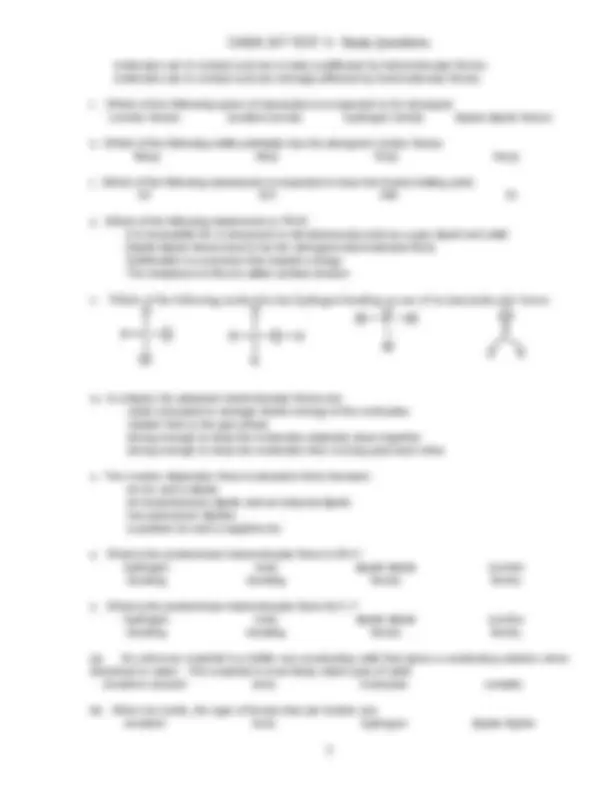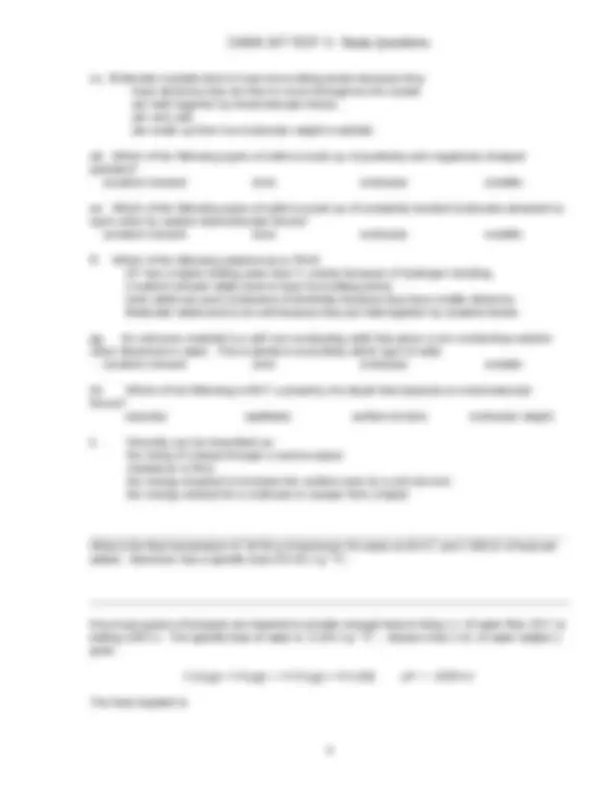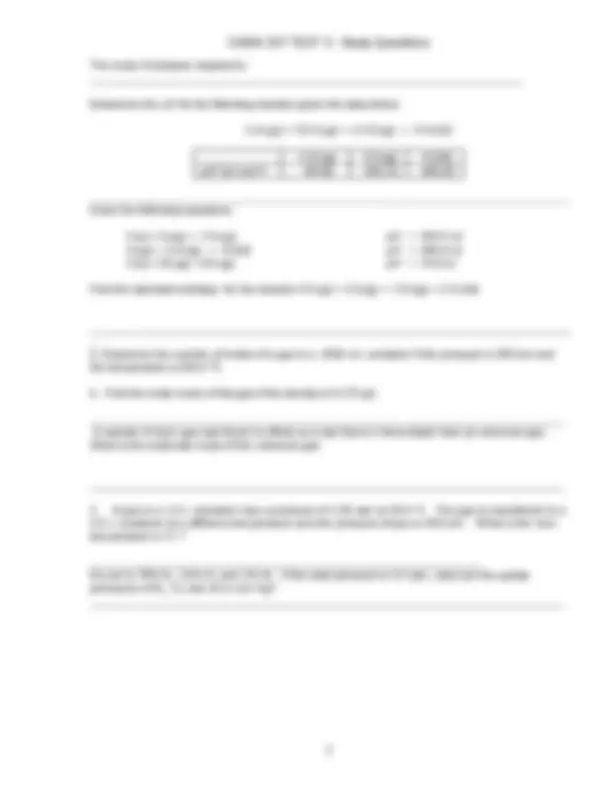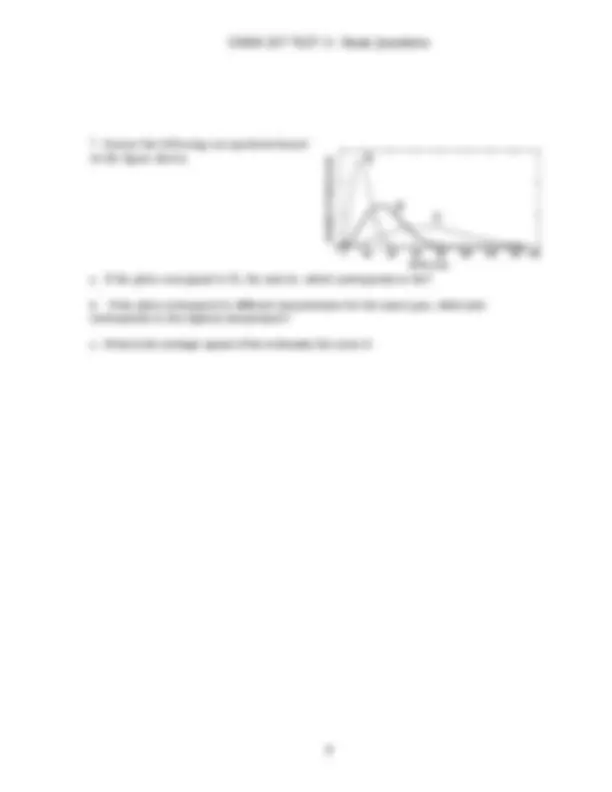






Study with the several resources on Docsity

Earn points by helping other students or get them with a premium plan


Prepare for your exams
Study with the several resources on Docsity

Earn points to download
Earn points by helping other students or get them with a premium plan
Community
Ask the community for help and clear up your study doubts
Discover the best universities in your country according to Docsity users
Free resources
Download our free guides on studying techniques, anxiety management strategies, and thesis advice from Docsity tutors
Material Type: Exam; Class: General Chemistry I; Subject: Chemistry; University: Shepherd University; Term: Unknown 1989;
Typology: Exams
1 / 8

This page cannot be seen from the preview
Don't miss anything!





Circle the correct answer a. Combustion of which of the following fuels is NOT a major source of greenhouse gases. natural gas coal hydrogen gasoline b Which of the following types of bonds has the highest bond energy. C-C C=C CC c Which of the following statements is TRUE Burning coal produces more greenhouse gases than burning oil. Gas contains less energy per gram than coal. SO 2 from coal combustion is a major contributor to acid rain The exhaust from automobiles is the major source of acid rain. d Which of the following is FALSE Fossil fuels are our main source of energy Coal is the most abundant fossil fuel Solar power cells are not yet practical for large scale use Nuclear power plants are a major source of air pollution e. Which of the following does NOT have units of joules temperature enthalpy heat work f. The temperature of both to a 10.0 g sample of iron and a 10.0 g. sample of water are increased by 10 oC. (specific heats: iron 0.453 J gK, water 4.18 J gK) Which statement is TRUE? The water sample absorbs more heat than the iron sample Both samples absorb the same amount of heat It is impossible to say which sample absorbs more heat. The iron sample absorbs more heat than the water sample g. CO 2 is a greenhouse gas because It is transparent to visible radiation but absorbs infrared radiation It is transparent to infrared radiation but absorbs visible radiation It is transparent to both infrared and visible radiation It absorbs both infrared and visible radiation h. In a particular process 30 J of work is done on a system and 45 J of heat are released by the system. What is E for the system in this process? -75 J 75 J 15 J -15 J i. Which equation corresponds to the enthaply of formation for H 2 SO 3 (l) H 2 (g) + 4S(s) + O 3 (g) H 2 SO 3 (l) 2H(g) + 4S(s) + 3O(g) H 2 SO 3 (l) H 2 (g) + 1/8 S 8 (s) + 3/2 O 2 (g) H 2 SO 3 (l) H 2 (g) + 1/8 S 8 (l) + 3/2 O 2 (g) H 2 SO 3 (l) Which of the following has an enthalpy of formation equal to zero? Fe(l) O 2 (g) S(s) H 2 (s)
j. The enthalpy change for the reaction N 2 H 4 (g) + 3 O 2 (g) 2 NO 2 (g) + 2 H 2 O(l) is given by H = 2Hf(NO 2 (g)) + 2Hf(H 2 O(l)) - Hf( N 2 H 4 (g)) H = Hf( N 2 H 4 (g)) - 2 Hf(NO 2 (g)) - 2Hf(H 2 O(l)) H = Hf(NO 2 (g)) - Hf( N 2 H 4 (g)) H = Hf(N 2 H 4 (g)) - 2 Hf(NO 2 (g)) - Hf(H 2 O(l)) k. Consider the following reaction. F 2 (g) + 1/2 O 2 (g) OF 2 (g) The initial pressures of the F 2 is 1 atm and the pressure of the O 2 is 2 atm. Which statement is true? F 2 is a limiting reagent O 2 is a limiting reagent Neither gas is a limiting reagent l. Which one of the following statements is FALSE about gases? Attractive and repulses forces between gas molecules are negligible The average kinetic energy of the gas molecules increases with mass The volume of gas molecules is negligible compared to the distance between them Gas molecules are in continuous motion m. The average speed of a gas Increases with increasing temperature but decreases with increasing mass Increases with both increasing temperature and increasing mass Decreases with both increasing temperature and increasing mass Decreases with increasing temperature but increases with decreasing mass n. If the total pressure of an ideal gas mixture is 1 atm and one of its components has a partial pressure of 100 mm Hg, then the pressure of the other component is 660 mm Hg 100 mm Hg 760 mm Hg impossible to determine o. Which of the following statements is TRUE if the temperature is constant? Every gas molecule has the same amount of kinetic energy All gas molecules are moving at the same speed The average kinetic energy of all types of gas molecules is the same The average speed of all types of gas molecules is the same p. If two one-liter flasks have a temperature of 300 K and contain gases at 2 atm and then The density of the two gases are equal The number of molecules in each flask is the same The masses of the two gases are equal The average speed of the molecules in the two flasks are equal q. Which of the following gases diffuses fastest at 300 K NF 3 CH 4 Ar HCl Which of the following is the best description of a gas? molecules are far apart from each other and are mostly unaffected by intermolecular forces molecules are far apart from each other and are strongly affected by intermolecular forces
cc. Molecular crystals tend to have low melting points because they have electrons that are free to move throughout the crystal are held together by intermolecular forces are very soft are made up from low molecular weight materials dd. Which of the following types of solid is made up of positively and negatively charged particles? covalent network ionic molecular metallic ee. Which of the following types of solid is made up of covalently bonded molecules attracted to each other by weaker intermolecular forces? covalent network ionic molecular metallic ff. Which of the following statements is TRUE HF has a higher boiling point than F 2 mainly because of hydrogen bonding. Covalent network solids tend to have low melting points Ionic solids are poor conductors of electricity because they have mobile electrons Molecular solids tend to be soft because they are held together by covalent bonds gg. An unknown material is a soft non-conducting solid that gives a non-conducting solution when dissolved in water. This material is most likely which type of solid. covalent network ionic molecular metallic hh. Which of the following is NOT a property of a liquid that depends on intermolecular forces? viscosity capillarity surface tension molecular weight ii. Viscosity can be described as the rising of a liquid through a narrow space resistance to flow the energy required to increase the surface area by a unit amount the energy needed for a molecule to escape from a liquid
What is the final temperature of 50.00 g of aluminum if it starts at 20.0 C and 1.500 kJ of heat are added. Aluminum has a specific heat of 0.90 J g^ C.
How many grams of propane are required to provide enough heat to bring 1 L of water from 20 C to boiling (100 C) The specific heat of water is 4.184 J g^ C. Assume that 1 mL of water weighs 1 gram. C 3 H 8 (g) + 5 O 2 (g) 3 CO 2 (g) + 4 H 2 O(l) H o^ = -2220 kJ The heat required is
The mass of propane required is
Determine the H for the following reaction given the data below C 2 H 6 ( g ) + 7/2 O 2 ( g ) 2 CO 2 ( g ) + 3 H 2 O( l ) C 2 H 6 ( g ) CO 2 (g) H 2 O(l) Hf (kJ mol -84.68 -393.51 -285.
Given the following equations
H 2 (g) + ½ O 2 (g) H 2 O(l) H^ = -285.8 kJ C(s) + 2H 2 (g) CH 4 (g) H^ = -74.8 kJ Find the standard enthalpy for the reaction CH 4 (g) + 2 O 2 (g) CO 2 (g) + 2 H 2 O(l)
_ a. Determine the number of moles of a gas in a 2000 mL container if the pressure is 350 torr and the temperature is 250.0 C. b. Find the molar mass of this gas if the density is 0.175 g/L.
A sample of neon gas was found to effuse at a rate that is 3 times faster than an unknown gas. What is the molecular mass of the unknown gas
Dry air is 78% N 2 , 21% O 2 and 1% Ar. If the total pressure is 2.0 atm, what are the partial pressures of N 2 , O 2 and Ar in mm Hg?
HEATING CURVE 200 300 400 500 600 700 800 900 1000 0 5 10 15 20 25 30 35 40 45 50 55 60 65 70 HEAT ADDED (kJ/mol) TEMPERATURE (C) A B C D E F
b. If the plots correspond to different temperatures for the same gas, which plot corresponds to the highest temperature? c. What is the average speed of the molecules for curve A.